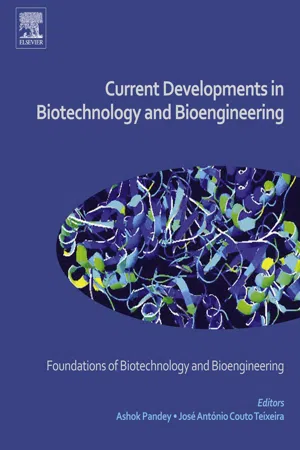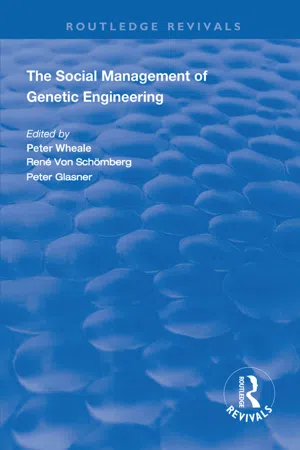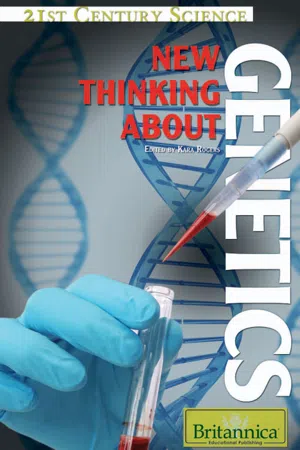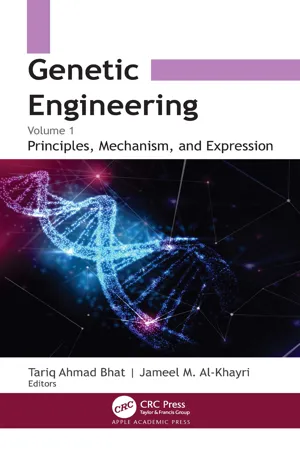Biological Sciences
Uses of Genetic Engineering
Genetic engineering is used in various fields such as agriculture, medicine, and industry. In agriculture, it is employed to create genetically modified crops with desirable traits. In medicine, genetic engineering is used to produce pharmaceuticals, develop gene therapies, and create genetically modified organisms for research. In industry, it is utilized to produce enzymes, chemicals, and biofuels.
Written by Perlego with AI-assistance
Related key terms
6 Key excerpts on "Uses of Genetic Engineering"
- eBook - ePub
Current Developments in Biotechnology and Bioengineering
Foundations of Biotechnology and Bioengineering
- Ashok Pandey, Jose Antonio Couto Teixeira(Authors)
- 2016(Publication Date)
- Elsevier(Publisher)
4Principles of Genetic Engineering
C. Oliveira† , T.Q. Aguiar† , and L. Domingues∗ University of Minho, Braga, PortugalAbstract
The field of genetic engineering has revolutionized many scientific fields, from fundamental sciences to medicine and engineering. The genetic engineering applications are wide ranging, but herein emphasis is given to its application in the biotechnology and bioengineering fields. Since their appearance in the early 1970s, the techniques used for modifying living organisms have evolved significantly. This chapter compiles information on the principles of genetic engineering, not only describing the basic techniques used in molecular biology and the basics of recombinant DNA technology, but also presenting more recent developments in these techniques, as well as up-to-date in silico tools. The specificities of the genetic engineering approaches used for the modification of an organism's metabolism (metabolic engineering) and for the production of high-value products, such as recombinant proteins, are also addressed. Examples of relevant applications in biotechnology and bioengineering are presented throughout the chapter.Keywords
Genetic engineering; Metabolic engineering; Molecular biology techniques; Recombinant DNA technology; Recombinant protein production4.1. Introduction
Genetic engineering (also called genetic modification) is the deliberate, controlled manipulation of an organism's genome using recombinant DNA technology. It therefore encompasses the use of a set of technologies to change the genetic makeup of cells, including the transfer of genes within and across species boundaries, with the objective of producing improved or novel organisms and/or unlimited amounts of otherwise unavailable or scarce biological products. Genetic engineering has revolutionized many scientific fields, from fundamental sciences to medicine and engineering, including biotechnology and bioengineering. Additionally, it has enabled the rise of new related fields, like metabolic engineering and synthetic biology, for which it is a vital pillar. So, fundamental knowledge on these techniques is relevant for people from various backgrounds and working in many different fields. Thus, the most popular basic techniques used in genetic engineering (Section 4.2 ) and the basics of recombinant DNA technology (Section 4.3 ) are described here for those not familiar with the field. Up-to-date applications and novel techniques are also presented. Finally, the specificities of the genetic engineering principles for metabolic engineering (Section 4.4.1 ) and recombinant protein production (Section 4.4.2 - eBook - ePub
- Peter Wheale, René von Schomberg(Authors)
- 2019(Publication Date)
- Routledge(Publisher)
1 The Social Management of Genetic Engineering: An IntroductionPeter Wheale and RuthMc NallyMany complex technologies pose substantial hazards and risks to individuals, communities, regions, or even to the entire planet. To impose such risks on people without even their tacit consent is undeniably an act of tyranny. (Zimmerman 1995, p. 92.)Genetic engineering is the manipulation of heredity or the hereditary material, and its aim is to alter cells and organisms so that they produce more or different chemicals or perform better or new functions. It is a pre-modern activity in the sense that people have tampered with heredity for as long as they have been cultivating crops and breeding livestock, and are responsible for countless alterations of the inherited properties of life forms on the planet. However, in this century, the science of genetics has transformed the traditional craft of genetic engineering into a modern science-related technology (see Freeman and Soete 1997, p. 15). The basic principles of classical genetics, which were developed between 1910 and 1940, changed the study of inheritance from a descriptive, anecdotal account of various hybrid crosses to a rigorous science. Applications of the principles of classical genetics had a profound effect on crop plant and domestic breeding, as 'rule-of-thumb' breeding procedures were replaced with rational regimes of artificial selection and hybridization, and artificial in vivo mutagenesis was used to generate genetic variation (see, for example, Stent 1971; Maener 1979).Scientific breakthroughs in microbiology, biochemistry and molecular biology since the Second World War comprise what is now often referred to as the 'molecular revolution' in the science of genetics, and it is 'molecular genetics' which underpins recombinant deoxyribo(se)nucleic acid (rDNA) technology. Scientists are now able to decode, compare, construct, mutate, excise, join, transfer and clone specific sequences of DNA, thus directly manipulating genetic material to produce organisms, cells and subcellular components. It is this microgenetic engineering (Wheale and Mc Nally 1988, chapters 1 - Hajiya Mairo Inuwa, Ifeoma Maureen Ezeonu, Charles Oluwaseun Adetunji, Emmanuel Olufemi Ekundayo, Abubakar Gidado, Abdulrazak B. Ibrahim, Benjamin Ewa Ubi(Authors)
- 2022(Publication Date)
- CRC Press(Publisher)
The authors have also predicted the application of biotechnology in high resilient farm animals, improved quality products, heightened production of food preservatives, and robust waste product utilization. They noted that the utilization is also possible in quality assurance schemes in reducing bad products deleterious to public safety. Wang et al. (2009) revealed that biotechnology plays a central role in the detection of species-species and genus-transferred microsatellites, or simple sequence repeat biomarkers. Studies have shown that DNA are spread throughout the eukaryotic cells in the mitochondrial or nucleus and chloroplasts. The utilization of microsatellite provides answers to the study of replication, evolution, repair, mutation or recombination. Hence, it has become a powerful tool in insect, animal, and plant gene study like genetic mapping, diversity studies, or assisted-marker selection. Mebratu et al. (2014) revealed that genetic engineering can be described as a process involved in the manipulation of genetic components of cells like RNA and/or DNA in order to improving yield, changing or modifying products. It involves in vitro or in vivo techniques, gene therapy or generation of new strains from microorganisms for industrial or pharmaceutical utilization. The authors revealed that the utilization of genetic engineering for animal production with resistance to pathogens, production of vaccines, and increasing yield in agriculture has grown exponentially. Though many concerns have been raised like alteration of natural process of genetic equilibrium, cost and ethical concerns, the utilization of this cutting-edge technology holds a promising future for livestock production. 8.3 Applications of Genetic Engineering 8.3.1 Disease Resistance In fighting pathogens, biotechnological tools are utilized such as in genetic selection of traits for livestock production with disease or pathogenic resistance- eBook - ePub
- Britannica Educational Publishing, Kara Rogers(Authors)
- 2010(Publication Date)
- Britannica Educational Publishing(Publisher)
ENETIC ENGINEERINGT he field of genetic engineering encompasses the artificial manipulation, modification, and recombination of DNA or other nucleic acid molecules in order to modify an organism or population of organisms. The term genetic engineering initially meant any of a wide range of techniques for the modification or manipulation of organisms through the processes of heredity and reproduction. As such, the term embraced both artificial selection and all the interventions of biomedical techniques, among them artificial insemination, in vitro fertilization (e.g., “test-tube” babies), sperm banks, cloning, and gene manipulation. Today, however, the term denotes the narrower field of recombinant DNA technology, or gene cloning, in which DNA molecules from two or more sources are combined either within cells or in vitro and are then inserted into host organisms in which they are able to propagate. Gene cloning is used to produce new genetic combinations that are of value to science, medicine, agriculture, or industry.DNA is the carrier of genetic information; it achieves its effects by directing the synthesis of proteins. Most recombinant DNA technology involves the insertion of foreign genes into the plasmids of common laboratory strains of bacteria. Plasmids are small rings of DNA; they are not part of the bacterium’s chromosome (the main repository of the organism’s genetic information). Nonetheless, they are capable of directing protein synthesis, and, like chromosomal DNA, they are reproduced and passed on to the bacterium’s progeny. Thus, by incorporating foreign DNA (for example, a mammalian gene) into a bacterium, researchers can obtain an almost limitless number of copies of the inserted gene. Furthermore, if the inserted gene is operative (i.e., if it directs protein synthesis), the modified bacterium will produce the protein specified by the foreign DNA. - eBook - ePub
Genetic Engineering
Volume 1: Principles Mechanism, and Expression
- Tariq Ahmad Bhat, Jameel M. Al-Khayri(Authors)
- 2023(Publication Date)
- Apple Academic Press(Publisher)
Chapter 3 Tools Used in Genetic EngineeringANKITA SHARMA,1 AHMAD ALI,1 and JOHRA KHAN2 ,31 Department of Life Sciences, University of Mumbai, Vidyanagari, Santacruz (E), Mumbai, Maharashtra, India2 Department of Medical Laboratory Sciences, College of Applied Medical Sciences, Majmaah University, Majmaah, Saudi Arabia3 Health and Basic Sciences Research Center, Majmaah University, Majmaah, Saudi ArabiaDOI: 10.1201/9781003378266-3ABSTRACT
The use of recombination technique was followed by many civilizations for increasing production in agriculture and animal husbandry, but due to lack of specialized tools, the outcome was less and limited. With the development of genetic engineering, many aspects of our lives are changed and it plays an important role in all fields from agriculture to disease diagnosis and treatment. In this chapter, we try to focus on different tools of genetic engineering that made many developments in modern science.3.1 Introduction
Genetic engineering is a tool used in modern biology to change an organism’s genetic structure using recombinant DNA (RDNA) technology (Flores, 2019 ). Conventionally, our ancestors used to regulate breeding by selecting offspring with required traits by manipulating their genomes indirectly (Oliveira et al., 2017 ). The definition that is recorded is “The process to modification of one or more genes is known as genetic engineering.” It is also known as genetic modification (Baltimore et al., 2015 ) or genetic manipulation (Akram et al., 2020 ).________________________________ Genetic Engineering, Volume 1: Principles, Mechanism, and Expression. Tariq Ahmad Bhat & Jameel M. Al-Khayri (Eds.) © 2023 Apple Academic Press, Inc. Co-published with CRC Press (Taylor & Francis)To develop a preferred phenotype in an organism, a selected gene from identified species is generally added to the genome of chosen plant or animal (Zachariah & Pappachen, 2009 ). The new DNA that is produced by segregating and replication of the genetic material of interest using RDNA technology (Bekana, n.d.; Muntaha et al., 2016 ) or by creating it artificially (Mehra et al., 2020 ). For injecting foreign DNA into a host organism, need to have a construct made (Ashok et al., 2015 ). The first DNA recombinant was developed by Paul Berg developed in 1972 (Berg & Mertz, 2010 ) by merging DNA of monkey virus SV40 with lambda virus DNA (Yi, 2008 - eBook - ePub
Pharmacognosy
Fundamentals, Applications and Strategies
- Rupika Delgoda, Simone Badal McCreath(Authors)
- 2016(Publication Date)
- Academic Press(Publisher)
At that time, biotechnology encompassed the use of living organisms for the production of new products from raw materials of biological origin. Hence the name consisting of a combination of the Greek words: bios—life; techno–technical; and logos—study. Since then the definition of biotechnology has been redeveloped a number of times [2], but the most widely accepted definition was given by the Organization for Economic Cooperation and Development (OECD) in 1981 [3]. The OECD defines biotechnology as “the application of scientific and engineering principles to the processing of materials by biological agents.” For much of the 20th century, the term “biotechnology” continued to be broadly used in reference to technologies ranging from the fermentation of products to the selective breeding of plants. In recent years, the term modern “biotechnology” has been used interchangeably with biotechnology and has become almost synonymous with genetic modification and the targeted utilization of the methods of molecular biology. The “modern” in modern biotechnology presumably differentiates between the present applications of genetic engineering and cell fusion from the past conventional methods of biotechnology such as fermentation and selective breeding. The definition of biotechnology as given by the European Federation of Biotechnology is “Biotechnology is the integration of biochemistry, microbiology and engineering sciences to achieve technological (industrial) application of the capabilities of microorganisms, cultured tissue cells and parts thereof” [3]
Index pages curate the most relevant extracts from our library of academic textbooks. They’ve been created using an in-house natural language model (NLM), each adding context and meaning to key research topics.





